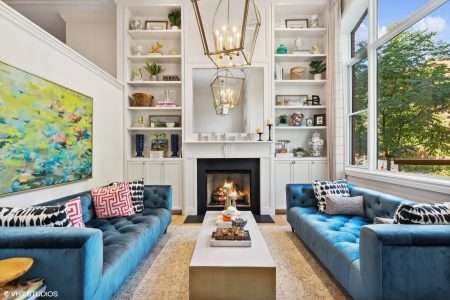Maximizing Your Home’s Usable Space: How to Improve Layout Without Major Renovations
As a longtime Chicago realtor and homeowner, I’ve seen firsthand how a home’s layout can either enhance daily life or create unnecessary frustration. Many homes—especially older ones—are designed with a surprising amount of square footage dedicated to hallways and walkways rather than truly livable space.
By taking a closer look at how your home flows, you can unlock more functionality and enjoyment in your daily life. And if you’re thinking about selling, showing buyers the full potential of your space can make your home even more appealing and valuable. The best part? With a few smart design choices, you can often transform these areas and reclaim more livable square footage, even without major renovations.
Step 1: Assess Your Floor Plan
Start by reviewing your home’s layout and identifying the dead spaces. Highlight in red all the areas dedicated solely to circulation—long hallways, oversized entryways, and awkward transition spaces. Once you see how much space is going unused, you can begin to reclaim it for better purposes.
Step 2: Transforming Walkways into Functional Spaces
Instead of treating hallways and passageways as purely transitional, consider these upgrades:
- Convert a Nook Into a Small Office or Reading Corner: A quiet alcove can be transformed into a compact work-from-home space or a cozy reading area with a stylish chair and built-in shelving.
- Reclaim Wasted Wall Space: Add floating shelves, slim bookcases, or built-in storage along wide hallways to add function without affecting traffic flow.
- Open Up Closed-Off Spaces: If possible, removing a non-structural wall can create a more open-concept layout, reducing wasted square footage and improving the home’s overall livability.
Step 3: Enhancing Long Hallways
For those lengthy corridors that remain, turn them into a stunning feature rather than a wasted passageway:
- Create a Gallery Walkway: Install gallery-style lighting and use the walls to showcase art, framed photography, or small 3D artworks like relief sculptures or textiles.
- Incorporate Functional Elements: Add a narrow console table for drop-zone storage or create a built-in display for books, plants, or decorative objects.
- Use Mirrors to Expand the Space: Strategic mirror placement can make a narrow hallway feel wider and more inviting.
Step 4: Expanding Livable Space Without Adding Square Footage
- Rethink Underused Rooms: If you have a formal dining room that rarely gets used, consider integrating it into your everyday living space.
- Dual-Purpose Furniture: Incorporate multi-functional pieces like fold-down desks, wall-mounted tables, and ottomans with storage to make every inch of space work harder.
- Reconfigure Entryways: Reduce oversized entryways or repurpose them into useful areas, such as adding a mudroom-style bench and storage.
Maximizing livable space isn’t just about making your home more enjoyable—it can also increase its resale value. Buyers are drawn to homes that showcase their full potential, and smart floorplan optimizations can make your property feel larger and more functional without an expensive renovation. Whether you’re selling or staying, reclaiming your home’s wasted space will make your home more efficient, stylish, and enjoyable to live in.
If you’re looking for expert advice on optimizing your home’s layout and increasing its market appeal, contact me today—I’d be happy to help!
Let’s Talk Layouts and Home Value!
CONTACT Debra TODAY!






